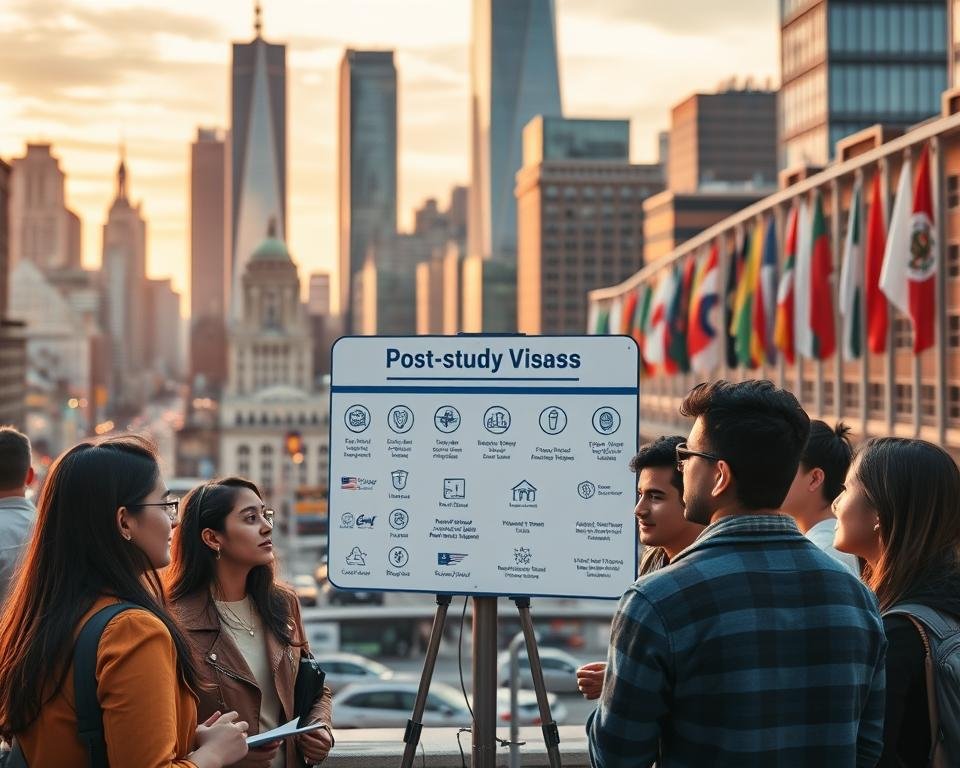Navigating Post-Study Visa Options after Graduation

"Change is the law of life. And those who look only to the past or present are certain to miss the future." - John F. Kennedy. This quote captures the journey of international students moving from school to work. After graduation, finding the right post-study visa is key for a place in the US job market.
International graduates want to turn their studies into careers. Knowing the different post-study visa options is essential. This part of their journey offers both chances and challenges that shape their future. We'll look at these options and the experiences of US visa holders, helping graduates navigate this important phase.
- Understanding Post-Study Visa Options for International Students
- Importance of Post-Study Work Permits
- How to Apply for a Post-Study Visa
- Post-Study Visa Options After Graduation in Student Visa
- Exploring Career Prospects with a Post-Study Visa
- Job Opportunities Available for International Graduates
- Student Visa Extension After Graduation
- Challenges Faced by Graduates Seeking Post-Study Work
- Post-Study Visa Pathways for International Students
Understanding Post-Study Visa Options for International Students
For international students, finding the right post-study visa can be tough. There are several options, like the Optional Practical Training (OPT) and the Training and Internship program (T1). These programs let students get real-world experience in their field.
It's key to know about student visa paths to make good job choices. Post-study work permits give graduates the chance to work in the US. Studies show that 242,000 foreigners in the US work through these programs, showing their importance.
Each visa has its own rules, like how long you can work and where. For students from India and China, knowing these rules is crucial. Many students face problems, making it urgent to understand visa paths. For more details, check here.

Importance of Post-Study Work Permits
The post-study work permit importance is huge. It lets international graduates get vital work experience. After years of studying, moving to the workforce is tough. This permit helps new graduates use their skills in real jobs, making it easier to find work.
Getting a post-study work permit boosts your job chances. Employers want people with real-world experience. Working in the U.S. helps build a strong resume and increases job prospects. Also, it lets graduates make important industry connections. These connections can lead to job offers and shape your career path.
In short, post-study work permits are key for moving from school to work. They are essential for international graduates aiming for a successful career.

How to Apply for a Post-Study Visa
Applying for a post-study visa needs careful planning and following rules. Students who want to work in the U.S. after graduating must know the steps. Knowing these steps helps make the application process smoother.
First, students need to collect important documents. These include a valid passport, proof of graduation, and letters from the university's International Programs office. These documents are key for applying for student visas and show you meet the requirements.
Then, fill out the visa application forms correctly. Mistakes in the application can cause delays or even denial. Students should also watch out for application fees and deadlines. Universities often help with this by offering resources or workshops.
It's also wise to talk to the International Programs office at your university. They can offer great help during the visa application process. Their knowledge helps keep you updated on immigration law changes or extra requirements.
After submitting the application, students should keep an eye on its status. Staying informed and ready for interviews is part of getting post-study work permits. This effort helps make the transition from student to professional smoother.

Understanding how to get a post-study visa is crucial. By carefully following each step and using available resources, international graduates can set themselves up for success in their careers.
Post-Study Visa Options After Graduation in Student Visa
International students in the United States often look into post-study visa options after graduation. It's important to know the different types of visas and what you need to qualify. This helps you make the right choice for your career path.
Types of available post-study visas
There are several post-study visas for international graduates looking for work. The F-1 visa is popular for its Optional Practical Training (OPT) program. This lets graduates work in their field for up to 12 months, with extra time for STEM fields.
Another option is the J-1 visa, for exchange visitors. They might get internships as part of their program.
Eligibility requirements
To get a post-graduate work visa, you need to meet certain criteria. You must have finished a recognized degree program and kept your visa status legal. Also, you must apply for work authorization on time.
It's crucial to check the U.S. Citizenship and Immigration Services' rules for each visa. This ensures you meet the requirements and increase your chances of getting a visa.
Exploring Career Prospects with a Post-Study Visa
International graduates can find great opportunities with a post-study visa. It lets them enter various industries looking for new talent. Tech, engineering, and business are key areas where skilled workers are in demand.
Using the skills learned in studies can make you stand out. Employers value diverse views and a strong education. When applying for jobs, highlight your academic success and any practical experiences you've had.
Internships are great for gaining real-world experience. They help you understand what employers want. Doing internships can also help you meet people in your field, which can lead to job offers.
Job Opportunities Available for International Graduates
International graduates have a unique chance to explore varied job opportunities after graduation. They can use a post-study visa to open doors to full-time employment, internships, and graduate programs. This allows them to gain valuable experience in their fields.
Using university career services is a smart move for international students. Many institutions offer resources to connect graduates with employers. Job fairs are also great for networking with industry professionals and learning about available positions.
To increase their chances of success, graduates should tailor their job search. Online job platforms can help find roles that match their qualifications. A strong resume and practice in U.S. interview techniques are key to showcasing skills and experiences.
Here’s a comprehensive overview of key job opportunities available to international graduates:
| Job Type | Description | Benefits |
|---|---|---|
| Full-time Employment | Permanently employed roles in various sectors. | Stability, experience, and benefits like health insurance. |
| Internships | Short-term roles that offer practical experience. | Networking opportunities and a chance to enhance skillsets. |
| Graduate Programs | Structured paths in large organizations for new graduates. | Training and mentorship opportunities, career progression. |
Finding jobs with a post-study visa is not just about any job. It's about finding roles that match your career goals and use your education. With persistence and the right resources, international graduates can successfully navigate the job market.
Student Visa Extension After Graduation
Extending a student visa after graduation is crucial for many international students. It lets them stay in the United States. The process involves several steps that need careful attention. It's important for those who want to work after graduation.
Process for extending your student visa
To start, graduates must collect the right documents. These include:
- Proof of enrollment in additional courses or programs
- Financial statements showing they can support themselves
- Current passport and visa documents
- Any extra forms needed by the U.S. Citizenship and Immigration Services (USCIS)
Being on time is key. You must apply before your visa expires. Applying late can mean you can't extend it. Start preparing your documents early to avoid problems.
For those thinking about working after graduation, knowing visa rules is important. A valid student visa can help until your new visa is ready. For more information, check out online resources.
Challenges Faced by Graduates Seeking Post-Study Work
Securing a job after studying abroad is tough for many. Visa rules can be confusing and frustrating. This makes it hard for graduates to find their place in the job market.
There's also a lot of competition. Many students are looking for the same jobs. To stand out, it's important to network, get work experience, and improve your language skills.
International students need to be ready for these challenges. They should learn about their field, improve their skills, and stay strong. Joining alumni groups and attending career events can help a lot.
Post-Study Visa Pathways for International Students
For international students, finding the right post-study visa pathway is key. It helps them move into the workforce after graduation. Knowing the different visa options can greatly impact your career, offering paths to jobs and residency.
Many students switch from a student visa to an employment visa. This can open doors to long-term career opportunities. Exploring options like the Optional Practical Training (OPT) program in the U.S. can give you valuable work experience. Getting advice from professionals is also wise, as visa rules can change often.
In summary, understanding post-study visa pathways is crucial for international students. It lets them make smart choices about their future careers. By looking at various visa options and thinking about long-term residency, students can link their education to their career goals.
If you want to know other articles similar to Navigating Post-Study Visa Options after Graduation You can visit the category Migration.

Leave a Reply